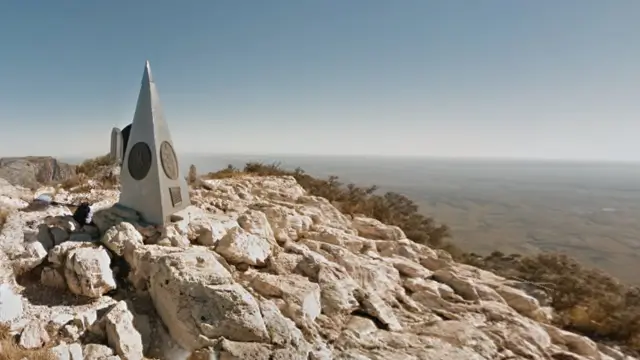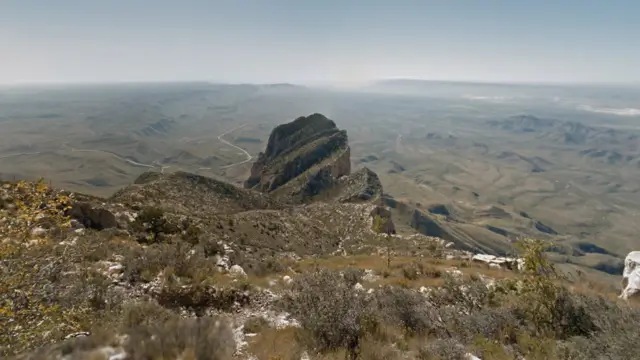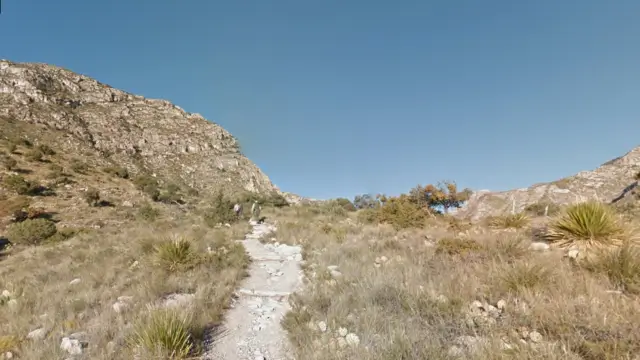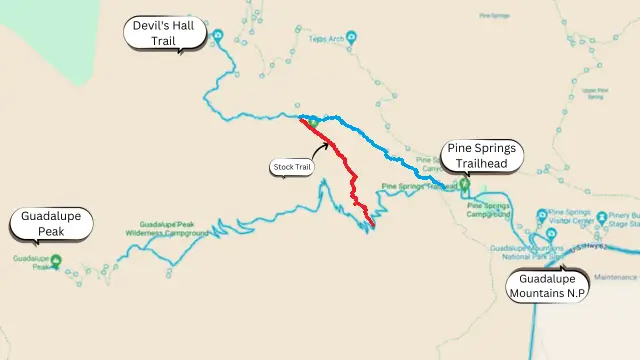How to Hike to Guadalupe Peak
Towering over the Chihuahuan Desert, Guadalupe Peak reigns as the highest point in Texas at a breathtaking 8,751 feet (2,667 meters). Reaching this summit is a rewarding, but challenging adventure.
The hike is a strenuous 8.4-mile round trip journey with a 3,000-foot elevation gain. Expect to spend 6 to 8 hours traversing switchbacks, scrambling over rocks, and soaking in the stunning scenery.
While the promise of reaching the “Top of Texas” is thrilling, Guadalupe Peak demands more effort to hike its high-altitude terrain, from arid deserts to lush forests, where the amount of oxygen available in the air decreases.
So, to conquer this legendary summit like a seasoned adventurer, come well-equipped and prepared. This guide will be your compass, navigating you through everything you need to know about how to hike to Guadalupe Peak. So, keep Reading!
“Guadalupe Peak is one of the most rewarding hikes in Texas. It’s a challenging climb, but the views from the top are simply spectacular. I recommend doing it in the spring or fall when the weather is mild and the wildflowers are in bloom.”
Jim Cox
Planning Your Hike to Guadalupe Peak

1. Best Time to Hike
Seasonality plays a crucial role in your Guadalupe Peak experience. While technically hikeable year-round, springtime (April-May) and fall (September-October) offer the most enjoyable conditions.
Spring sees the desert bloom with wildflowers, painting the slopes in vibrant hues. Fall brings cooler temperatures and breathtaking foliage, transforming the landscape into a fiery masterpiece. Summer heat can be brutal, while winter presents icy patches and potential road closures.
2. Permits & Reservations
The good news is that Guadalupe Peak welcomes hikers without requiring reservations, leaving you free to decide on your own schedule, but backcountry camping permits are needed. Read more about Guadalupe Mountains National Park Wilderness Permits.
Don’t let this fool you into procrastination. Pine Springs Visitor Center is known for its limited parking, especially on weekends.
Arrive early, ideally before sunrise, to snag a spot and avoid disappointment. Early mornings also benefit from cooler temperatures, making the initial climb more pleasant.

Gear Up for the Hike
Here are the essential gear items you should consider for the hike:
- Tough Boots: Wear comfy hiking boots with good grip for the rocky climb. Break them in beforehand!
- Backpack Buddy: Bring a sturdy backpack to carry your stuff and keep things balanced.
- Water Wise: Pack at least one gallon of water per person per day. Drink half, then think about heading back.
- Layered Up: Pack clothes you can wear in layers, because it gets colder and windier at the top!
- Sun Smarts: Shield yourself from the sun with sunscreen and a hat, especially since there’s not much shade.
- Pole Patrol: Trekking poles can help you stay steady on the rocks and downhill.
- Leave No Trace: Pack a special bag to carry out all your waste, toilet paper, and hygiene products. Follow the rules, especially where there are no bathrooms.
- First Aid Fix: Bring a basic first-aid kit for small bumps and surprises.
- Lighten Up: If you’re aiming for sunrise or sunset at the peak, pack a headlamp or flashlight.
- Weather Monitoring Tools: Keep an eye on the forecast, especially in summer when storms can come quickly. Turn back if things get nasty or windy.
Hiking to Guadalupe Peak

To start hiking Guadalupe Peak, you’ll begin at the Pine Springs Trailhead, located half a mile from the Pine Springs Visitor Center. Here are more details about the trail:
The trail begins at the Pine Springs Trailhead, which is half a mile from the Pine Springs Visitor Center. Check in at the visitor center, then turn right out of the visitor center parking lot.
Follow the signs for the Guadalupe Peak Trail. The trail is approximately 8.4 miles round trip, with a 3,000-foot elevation gain. It is considered very strenuous and takes an estimated six to eight hours to complete.
The trail is strenuous and includes steep sections. The steepest part of the hike is encountered in the first mile and a half as the trail switchbacks up the first steep slope. Be cautious not to cut across the switchbacks to prevent accelerated erosion.
As you ascend, the views will improve with every switchback. The trail takes you through various ecosystems, including the high desert and high elevation forests. On a clear day, you’ll be rewarded with fantastic views of the surrounding mountains and desert.
- About three miles into the hike, the trail tops out at a false summit. From here, it’s a little more than a mile to the actual summit.
- The trail passes through a sparse forest of ponderosa pine after the false summit.
- After passing a backcountry campsite, the trail descends slightly and crosses a wooden bridge before beginning the final climb to the summit.
- The summit offers breathtaking views of the surrounding mountains and desert on clear days.
Trail surfaces consist of loose rock or hardened rock surfaces. Hiking or trekking poles are highly recommended for stability. Trail widths vary from two to six feet, depending on the section.
Devil’s Hall Trail

If you’re itching to explore Guadalupe Mountains National Park but not quite up for the intense trek to Guadalupe Peak, fear not! Devil’s Hall Trail is alternative trail that offers a more relaxed yet equally scenic experience.
- Distance: 11.25 miles round trip
- Total Ascent: 3,450 feet
- Lowest Elevation: 5,850 feet
- Highest Elevation (Guadalupe Peak): 8,751 feet
- Time: 6 to 10 hours
One such gem is Devil’s Hall Trail, a scenic route skips the strenuous climb but still lets you soak in the park’s magic.
Here’s a smart tip: on your way back from Guadalupe Peak, watch for a trail junction marked “no stock beyond this point.” Turn left onto the shorter stock trail that winds down for ¾ mile and joins Devil’s Hall Trail. This nifty shortcut saves you from retracing your steps!
Follow Devil’s Hall Trail for another mile until you reach the end. Then, simply loop back to the trailhead using the same path.
Word of caution: While Devil’s Hall is no Everest, the rock scrambling requires vigilance, especially if you’re already tired from Guadalupe Peak. Even seasoned hikers found it a good workout. So, only add Devil’s Hall to your trip if you consider yourself a fit and focused adventurer.
“While not technically difficult, the trail requires good balance and sure footing. Be prepared for some loose scree and exposed sections, especially in the final stretch.”
John L.
Safety and Considerations
When you are gearing up for an intense 8.4-mile round trip with a hefty 3,000-foot elevation gain, brace yourself for a demanding trek that promises stunning views but demands your utmost preparation.
Read also: Hiking The Pacific Crest Trail: Beginner’s Guide
Conclusion
In conclusion, conquering the summit of Guadalupe Peak is a feat that promises both challenge and reward. The strenuous 8.4-mile round trip, with a formidable 3,000-foot elevation gain, demands preparation and stamina. Yet, the breathtaking views from the “Top of Texas” make every step worth it.
As you plan your adventure, consider the alternative but equally scenic Devil’s Hall Trail. With a smart shortcut on your way back from Guadalupe Peak, this trail offers a more relaxed experience without compromising on the beauty of the park.
In the spirit of responsible hiking, always prioritize leave-no-trace principles. Ensure you’re well-equipped, hydrated, and mindful of your physical condition. The safety considerations, from water consumption to descent challenges, are crucial for a successful and enjoyable hike.
As you embark on this journey, relish the sense of accomplishment that summiting Guadalupe Peak brings. The memories forged amid the high-altitude terrain, from rocky climbs to serene forests, are truly unparalleled.
So, fellow adventurers, I invite you to explore the beauty and challenges of Guadalupe Mountains National Park. Whether you choose the iconic Guadalupe Peak or the scenic Devil’s Hall Trail, let every step be a celebration of nature’s wonders. Lace up those boots, embrace the adventure, and leave your mark responsibly on this captivating landscape.
Finally, Don’t hesitate to share your thoughts down below, Happy hiking!
Sources: Hike Guadalupe Peak, from NPS website.